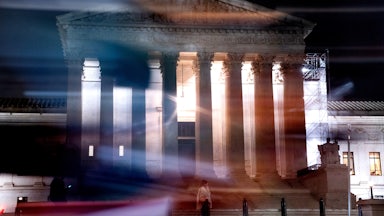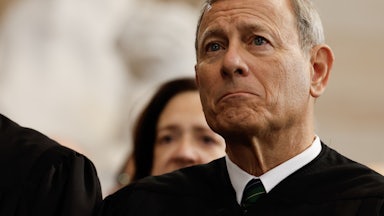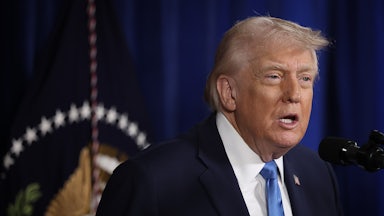On Monday, the Supreme Court will hear oral arguments in NetChoice v. Paxton and its companion case, Moody v. NetChoice. NetChoice is a trade association that represents internet platforms such as Facebook, Google, and Twitter—some of the biggest names in Silicon Valley. With a party like this, the case is bound to be pivotal for the many millions of users of digital services. Sure enough, while the debate at the center of the suit may seem abstruse at first, it could determine whether Big Tech platforms operate fairly for all who use them.
NetChoice sued Texas and Florida to block state laws that were enacted to restrict social media networks’ ability to suspend or otherwise marginalize users. According to NetChoice, the laws violate these companies’ First Amendment rights and, therefore, should be struck down as unconstitutional.
The Open Markets Institute, where we work, filed an amicus brief in support of the states. Those who are familiar with the organization may be surprised by our siding with two conservative state governments. We, however, believe that the underlying question of whether states and the federal government have the authority to regulate social media and other internet platforms as common carriers is critical. If the Supreme Court decides in favor of Big Tech platforms by ruling that they cannot be designated and managed as common carriers, it will take essential regulatory tools away from the government.
Why is this such an important issue? At heart, common carriage requires certain entities to generally serve all paying customers on the same terms. While most people—well, at least those of us who are lawyers—probably think of railroads and telecommunications companies when they hear “common carrier,” the principle stretches back several hundred years to a time long before these industries even existed. Its origins, in fact, were comparatively humbler than its modern application: Courts in England and the United States historically placed special duties on certain businesses such as inns and ferries, hence a distinct body of law called “the common law of innkeepers and common carriers.”
Notably, in many states, this meant that a hotel in the early nineteenth century could not deny service to customers based on race or ethnicity. And so the common carrier norm played a vital role in the modern world, informing multiple civil rights laws.
The courts did not indiscriminately designate businesses as common carriers. Rather, common carriers had to possess one of two distinguishing features. First, some businesses, expressly or implicitly, held themselves out as open to everyone. That is why courts deemed inns, ferries, wharves, delivery services, and farriers as common carriers. Second, certain enterprises required special public permissions to operate. For instance, gas companies needed municipal franchises to use the streets to lay pipes for distributing fuel. Businesses that belonged to one of these two classes could be subject to common carrier duties. By contrast, a manufacturing business or a private boarding house would not be a common carrier.
The courts applied the common carrier concept in a dynamic fashion. It was not fixed in amber in the distant past. Over time, courts and subsequently legislatures expanded common carriage obligations to cover new industries, such as railroads and electricity. Although the telegraph did not exist at the inception of common carriage, the Supreme Court of Vermont in 1889 described the lines of the Western Union Telegraph Company as “a common carrier of speech for hire.”
The common carrier concept remains alive and well. The judicial reinterpretation of the First Amendment to protect corporate prerogatives has not led to the death of common carriage principles for communications networks. In upholding the Federal Communications Commission’s 2015 net neutrality order, a court of appeals wrote, “Common carriers have long been subject to nondiscrimination and equal access obligations akin to those imposed by the [FCC] rules without raising any First Amendment question.” The late Justice Sandra Day O’Connor, an appointee of President Ronald Reagan, stated, “If Congress may demand that telephone companies operate as common carriers, it can ask the same of cable companies.” Congress and the courts treated these networks not as expressive outlets themselves but as conduits to facilitate the speech of others.
Social media platforms fit within notions of common carriage. They are open to all comers—a person only needs to provide their name and email address to start using their platforms and posting. The platforms do some curation; they promote select content and users and suppress others. But they are distinguishable from magazines and newspapers. The New Republic, for example, reserves full authority to run the stories and commentaries it chooses and makes clear its editorial and news pages are not open to the public. Twitter and YouTube do not do that.
How would common carriage apply to social media and other tech platforms? A good system would restrict the ability of Twitter, YouTube, and Facebook to suspend users without cause. As a general matter, they couldn’t ban users for expressing views they find distasteful—whether conservative, centrist, or progressive.
NetChoice and the social media companies they represent want us to believe that common carriage would lead to an explosion of racist, misogynistic, and other bigoted content. But well-designed common carrier rules would merely establish a presumptive right to post content. Such rules wouldn’t lead to a free-for-all in which social media becomes—or persists as—a sewer of violent and libelous speech. Just as common carrier doctrine permitted railroads to deny service to belligerent passengers, a good system of federal or state regulation should allow social media platforms to suspend users for threatening or defaming others, using racial and other slurs, posting pornography, or employing the networks to conduct illegal activity. Under this system, the elite and powerful few who answer to no one (cough, Elon Musk) would no longer solely decide what constitutes reasonable speech and what runs afoul of social norms.
Moreover, the common carriage approach isn’t a recipe for more hate speech: This problem is a function of these platforms’ basic business model—surveillance advertising. In the 1990s, people could express white supremacist views on bulletin boards, but their posts wouldn’t be amplified and disseminated widely the way they often are today.
But today’s social media companies profit from keeping people online as much as possible, both to sell more ads and to track users—the better to develop more fine-grain profiles of our wants, needs, and fears. That means incendiary content, whether conspiracy theories about the Rohingya in Myanmar, the 2020 presidential election in the United States, or undocumented immigrants, sells. It keeps people highly engaged and very online. Indeed, a casual examination of recent history indicates that social media companies, at present, are not responsible stewards, but are instead leading purveyors of hate speech.
In addition to social media, common carriage principles could be applied to other tech companies that hold themselves out as open to the public. For example, lawmakers could designate cloud computing companies, such as Amazon Web Services, as common carriers. These businesses provide an important service that is purportedly available to all paying customers and should be operated on a nondiscriminatory basis.
Likewise, Google Search could also be regulated as a common carrier: at present, Ohio is seeking to do just that. In Ohio v. Google, the state attorney general is asking a court to declare Google a common carrier under state law. Other states could adopt its model and seek to have Google declared as a common carrier as well.
What does common carriage look like if applied to Google Search? At the outset, we acknowledge some discrimination is unavoidable in online search because results that coughed up disorganized information would be useless. To be helpful, Google must determine which 10 links show up on the first page of search results and which links will be pushed to lower pages.
But a system of common carriage would limit the grounds for discrimination, much like a hotel cannot deny service to a paying guest based on their race or ethnicity but can do so if they arrive late after all rooms are occupied or threaten staff. Google would be prevented from elevating its own affiliates or contractually favored partners in organic search results. In 2017, the European Commission ruled that Google abused its dominant position and fined the company 2.42 billion euros for elevating its own comparison shopping service over those offered by independent rivals. Common carriage would prevent Google from engaging in similar conduct in the future.
Preserving the authority of the states and federal government to enact common carrier rules on social media and other tech platforms is vital. The two of us have no affinity for the current governments of Texas and Florida and are skeptical of the laws being challenged in the NetChoice cases. But that does not blind us to the stakes. The ordinary fix for bad laws is legislative amendment or repeal, not asking the Supreme Court to play super-legislature. Stripping government of the authority to enact common carrier rules for digital platforms would further aggrandize judicial and oligarchic power in our country.










